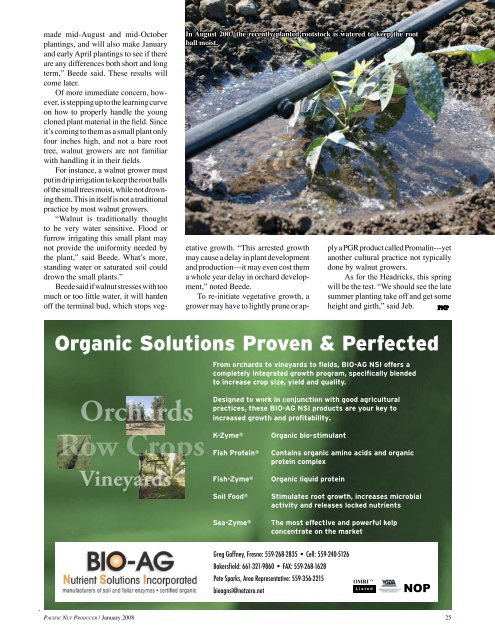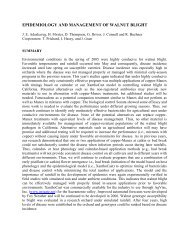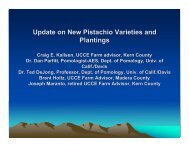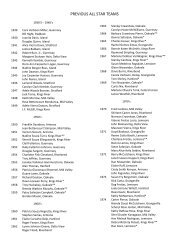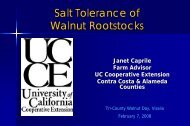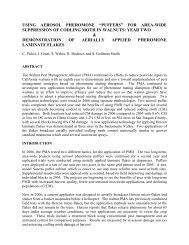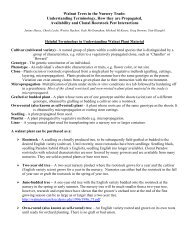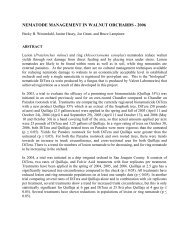Walnut Rootstock Clones - Kings County
Walnut Rootstock Clones - Kings County
Walnut Rootstock Clones - Kings County
You also want an ePaper? Increase the reach of your titles
YUMPU automatically turns print PDFs into web optimized ePapers that Google loves.
In August 2007 the recently planted rootstock is watered to keep the root<br />
ball moist.<br />
made mid-August and mid-October<br />
plantings, and will also make January<br />
and early April plantings to see if there<br />
are any differences both short and long<br />
term,” Beede said. These results will<br />
come later.<br />
Of more immediate concern, however,<br />
is stepping up to the learning curve<br />
on how to properly handle the young<br />
cloned plant material in the field. Since<br />
it’s coming to them as a small plant only<br />
four inches high, and not a bare root<br />
tree, walnut growers are not familiar<br />
with handling it in their fields.<br />
For instance, a walnut grower must<br />
put in drip irrigation to keep the root balls<br />
of the small trees moist, while not drowning<br />
them. This in itself is not a traditional<br />
practice by most walnut growers.<br />
“<strong>Walnut</strong> is traditionally thought<br />
to be very water sensitive. Flood or<br />
furrow irrigating this small plant may<br />
not provide the uniformity needed by<br />
the plant,” said Beede. What’s more,<br />
standing water or saturated soil could<br />
drown the small plants.”<br />
Beede said if walnut stresses with too<br />
much or too little water, it will harden<br />
off the terminal bud, which stops vegetative<br />
growth. “This arrested growth<br />
may cause a delay in plant development<br />
and production---it may even cost them<br />
a whole year delay in orchard development,”<br />
noted Beede.<br />
To re-initiate vegetative growth, a<br />
grower may have to lightly prune or apply<br />
a PGR product called Promalin---yet<br />
another cultural practice not typically<br />
done by walnut growers.<br />
As for the Headricks, this spring<br />
will be the test. “We should see the late<br />
summer planting take off and get some<br />
height and girth,” said Jeb. PNP<br />
<br />
<br />
<br />
<br />
<br />
<br />
<br />
<br />
<br />
<br />
<br />
<br />
<br />
<br />
<br />
<br />
<br />
<br />
<br />
<br />
<br />
<br />
<br />
<br />
<br />
<br />
<br />
<br />
Greg Gaffney, Fresno: 559-268-2835 • Cell: 559-240-5126<br />
Bakersfield: 661-321-9860 • FAX: 559-268-1628<br />
Pete Sparks, Area Representative: 559-356-2215<br />
bioagnsi@netzero.net<br />
OMRI TM<br />
L i s t e d<br />
NOP<br />
Pa c i f i c Nu t Pr o d u c e r / January 2008<br />
25


